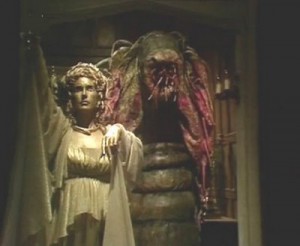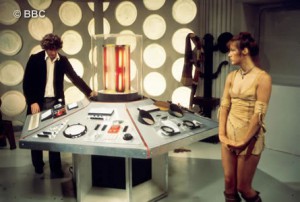 “There are four thousand million people on this planet, and if I’m right, within a year there will be only one. Just one.” —The Doctor
“There are four thousand million people on this planet, and if I’m right, within a year there will be only one. Just one.” —The Doctor
In a case of complete mood whiplash after last week, we’re back to an adventure in the Gothic Horror genre that it turns out we haven’t quite left behind. If this story had appeared in the middle of last season, not only would it fit right in but I might also call it the darkest horror story of that era of the program. The script by Chris Boucher was commissioned under Hinchcliffe and Holmes and taped before last week’s “Invisible Enemy,” so it bears the stamp of the outgoing era.
A small group of scientists are just back from Kenya after excavating a fossil that shouldn’t exist: an anatomically modern human skull at least 8 million years older than the earliest known hominid (let alone the earliest modern humans). They’re led by physicist Professor Fendelman, who made his fortune from his genius electronic inventions, then became interested in archaeology after discovering a method of sensing the past using a “sonic time scanner.” Fendelman detected a massive energy surge at the moment the original owner of the skull died, and believes the skull may be that of an extraterrestrial visitor.
Meanwhile the Doctor detects the sonic time scanner in use and lands the TARDIS to put a stop to it— he knows that such a time scanner will eventually cause a “temporal implosion” and destroy the planet it’s operating on. But he and Leela find something even more dangerous: the skull is that of the Fendahl, a life form that first appeared on the Solar System’s fifth planet (now the asteroid belt) and feeds directly on life energy. It was so inimical to all life everywhere that the Time Lords put the whole fifth planet in a time loop so that it never actually existed in the first place. But they were too late: the Fendahl had already escaped to Earth, and for twelve million years since it has been guiding human evolution with the goal of finally producing one single individual into whom it can be reborn. If the Fendahl succeeds, Earth’s fate will be the same as that of the fifth planet: within a year, the Fendahl itself will be only life form left on the planet.
This story revisits ground Dr Who last explored in the Jon Pertwee adventure The Daemons, revealing the alien origin of Earthly legends about witchcraft and black magic (continuity fans take note: this means it directly contradicts the earlier story, so if you like “playing the game” and reconciling everything into a single continuity, you have your work cut out for you). Image of the Fendahl also owes a great deal to the 1950’s BBC sci-fi serial Quatermass and the Pit, in which an archaeological dig uncovers evidence of an ancient attempt by Martians to remake early hominids in their image. This story takes a far darker tone than UNIT’s encounter with the occult. There’s an atmosphere of dread hanging over everything right from the opening scene in which a lone hiker in the woods at night is stalked and killed by an unseen monster.
There are some very scary touches: the slug-like fendahleen, projections of the Fendahl, are slow-moving but exert telekinetic control over their victims’ muscles. What that means is that, as in one familiar type of nightmare, you have a nice long time to see them coming for you while you can’t run away. (These days, Steven Moffat would build a whole story out of that concept alone.) The Fendahl skull glows when it takes control of scientist Thea Ransome, its intended host, and several times the screen shows Thea’s face and the glowing skull superimposed, and aligned perfectly so that it looks almost like the living woman’s skull is glowing through her skin. An old woman with second sight makes dark pronouncements that seem melodramatic on the page but are delivered perfectly by the actress playing her, contributing to the air of foreboding.
The final episode somewhat lets the story down. It doesn’t succeed in giving us a climax with the same kind of nail-biting tension that the suspenseful buildup deserves. Once the Fendahl actually appears on the scene, there doesn’t seem to be enough urgency to the characters’ efforts to stop it: for all the frantic warnings about how dangerous the Fendahl is, our heroes find it much too easy to run around doing all sorts of things while it just stands there. The fault is more in the staging of the scenes than in the story itself, but it’s there.
Still, the slightly-static final episode doesn’t let things down too badly, and the story overall holds up as one of the scarier, if not scariest, outings of the Classic series.
Details
 I meant to mention this last week, but there’s a new set for the TARDIS console room. The wood-paneled version introduced last season looked good, but it was actually made of wood paneling and when production resumed for the new season it was found to have badly warped and deteriorated in storage. Realizing that trying to fix it up would just mean lots of ongoing maintenance, the new production team replacing it with a set owing more to the original 1963 console room, and made of more storage-friendly materials. Although audiences first saw the new set in “The Invisible Enemy,” Fendahl was actually the first episode taped using it, so perhaps it fits that I waited to mention it until now! One feature of the new set: the distinctive “roundels” of the TARDIS’ interior walls were translucent and could be lit from behind, as seen in the picture above, allowing the director to give the whole set a very different look than if it was lit only from the front. This feature would be used for effect from time to time, although front-lighting will be the norm. This TARDIS set will remain in use until the end of the Classic series, with a minor makeover introduced in The Five Doctors.
I meant to mention this last week, but there’s a new set for the TARDIS console room. The wood-paneled version introduced last season looked good, but it was actually made of wood paneling and when production resumed for the new season it was found to have badly warped and deteriorated in storage. Realizing that trying to fix it up would just mean lots of ongoing maintenance, the new production team replacing it with a set owing more to the original 1963 console room, and made of more storage-friendly materials. Although audiences first saw the new set in “The Invisible Enemy,” Fendahl was actually the first episode taped using it, so perhaps it fits that I waited to mention it until now! One feature of the new set: the distinctive “roundels” of the TARDIS’ interior walls were translucent and could be lit from behind, as seen in the picture above, allowing the director to give the whole set a very different look than if it was lit only from the front. This feature would be used for effect from time to time, although front-lighting will be the norm. This TARDIS set will remain in use until the end of the Classic series, with a minor makeover introduced in The Five Doctors.- Leela also gets a new “dress” in this story, which you can also see in the picture above. It’s even skimpier than her usual. Cheesecake aside, however, the new costume makes a good character point about Leela: she has the TARDIS wardrobe available to her (and the Doctor’s had her dress in period clothes when visiting Earth’s past) but when she wants a new outfit, she makes it herself, in a style and with materials familiar to her— which is exactly what someone with Leela’s background would do. She won’t be wearing the new costume all through the rest of the season— at the end of this story she changes back to her old one, and after doing so is irritated when the Doctor obliviously compliments her on the “new” dress.
- This episode was written and made before K-9 was introduced, so a pair of brief scenes were added later, at the beginning and end, showing that K-9 had malfunctioned and the Doctor was repairing him.
- Some fans disparage the monster design on the fendahleen, but my reaction is that they look both convincing and creepy (with allowances made for what Dr Who’s budget could allow). Feel free to make up your own mind from the picture at top (the gold woman is the Fendahl, the monster next to her is a fendahleen).
- There’s a nice little touch of narrative suspense at one point: after realizing the Fendahl is at work, the Doctor tells Leela they’ll have to forget about the time scanner for the moment and deal with the greater threat. “But you said it could destroy the planet,” Leela reminds him. “We’ll just have the take the chance,” the Doctor answers, “they can use the time scanner for 100 hours before the implosion occurs.” We cut immediately to Fendelman operating the scanner with a screen that shows a running count of how long it’s been used: 98 hours and 56 minutes. And counting…
- This story introduces for the first time the idea that ghosts and hauntings are caused by naturally-occurring time fissures that allow people to glimpse different eras, and that growing up near such fissures can cause a person to develop second sight. The new series would play with this idea in “The Unquiet Dead,” which introduced the time rift in Cardiff that would in turn feature in the spin-off Torchwood.
- Trivia corner: actress Wanda Ventham, who plays Thea Ransome, is the mother of Benedict Cumberbatch.
Next Week:
“The Sunmakers,” 4 episodes.

